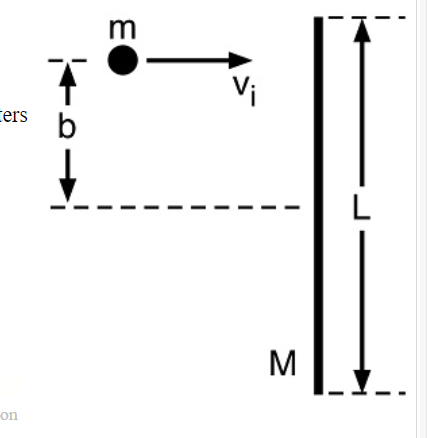The figure shows the view looking down onto an air hockey table. A puck collides with a stationary bar. The collision is completely inelastic. The bar has mass M = 1.55 kilograms and length L = 1.14 meters. The puck has mass m = 0.455 kilograms and is initially moving at vi = 7.27 perpendicular to the bar. The puck collides with the bar at a location of b = 0.485 meters from the center of the bar. Note that the size of the puck is negligible compared to the length of the bar. Calculate the angular speed (rad/s) about the center of mass of the puck-and-bar system just after the collision.
The figure shows the view looking down onto an air hockey table. A puck collides with a stationary bar. The collision is completely inelastic. The bar has mass M = 1.55 kilograms and length L = 1.14 meters. The puck has mass m = 0.455 kilograms and is initially moving at vi = 7.27 perpendicular to the bar. The puck collides with the bar at a location of b = 0.485 meters from the center of the bar. Note that the size of the puck is negligible compared to the length of the bar. Calculate the angular speed (rad/s) about the center of mass of the puck-and-bar system just after the collision.
An Introduction to Physical Science
14th Edition
ISBN:9781305079137
Author:James Shipman, Jerry D. Wilson, Charles A. Higgins, Omar Torres
Publisher:James Shipman, Jerry D. Wilson, Charles A. Higgins, Omar Torres
Chapter12: Chemical Bonding
Section12.2: Law Of Definite Proportions
Problem 1PQ
Related questions
Question
The figure shows the view looking down onto an air hockey table. A puck collides with a stationary bar. The collision is completely inelastic.
The bar has mass M = 1.55 kilograms and length L = 1.14 meters. The puck has mass m = 0.455 kilograms and is initially moving at vi = 7.27 perpendicular to the bar. The puck collides with the bar at a location of b = 0.485 meters from the center of the bar. Note that the size of the puck is negligible compared to the length of the bar.
Calculate the angular speed (rad/s) about the center of mass of the puck-and-bar system just after the collision.

Transcribed Image Text:ters
on
b
m
I
M
Expert Solution
This question has been solved!
Explore an expertly crafted, step-by-step solution for a thorough understanding of key concepts.
This is a popular solution!
Trending now
This is a popular solution!
Step by step
Solved in 5 steps

Knowledge Booster
Learn more about
Need a deep-dive on the concept behind this application? Look no further. Learn more about this topic, physics and related others by exploring similar questions and additional content below.Recommended textbooks for you

An Introduction to Physical Science
Physics
ISBN:
9781305079137
Author:
James Shipman, Jerry D. Wilson, Charles A. Higgins, Omar Torres
Publisher:
Cengage Learning

An Introduction to Physical Science
Physics
ISBN:
9781305079137
Author:
James Shipman, Jerry D. Wilson, Charles A. Higgins, Omar Torres
Publisher:
Cengage Learning